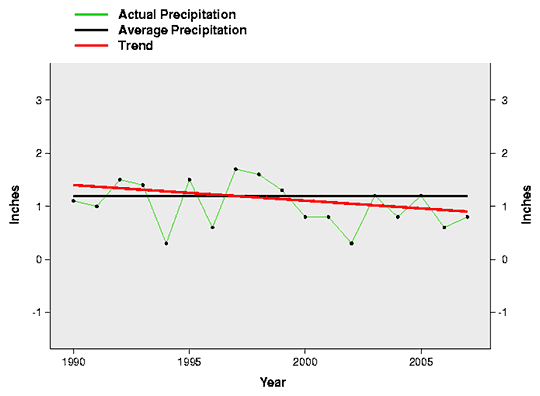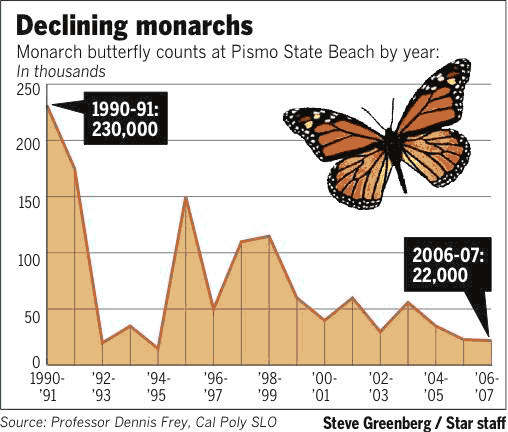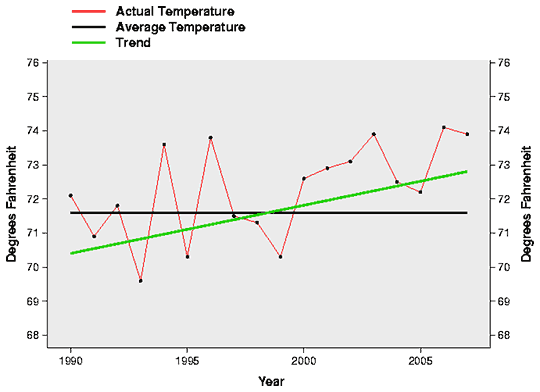Reign of the Monarchs in Decline?
Monday, February 25th, 2008 at 12:41 pm by JimFiled under Western Monarchs | 3 Comments »
The Ventura County Star recently ran an article by Zeke Barlow “Plight of the butterflies” with the subtitle “Reign of the monarchs is in decline, but no one knows reason for the drop in population”. The reasons offered for the decline varied from drought to parasites to loss of habitat. No doubt it will be difficult to sort out the various causes and it may not be possible to assign a specific reason, or reasons, for the decline due to our incomplete knowledge of where the monarchs that populate the coastal California overwintering sites breed. Nevertheless, the article caused me to rush off to my favorite climate site (Climate at a Glance) to check on the temperature and moisture over the 1990 to 2007 period – the interval for which there is good data on the total numbers of monarchs at the Pismo Beach overwintering site. The precipitation and temperature data shown in the two figures below represent the Western Region that consists primarily of California and Nevada. The data for California alone are similar.
Let’s look at precipitation first:

Figure 1. Precipitation for the Western Region during the Summer (Jun-Aug) 1990-2007 Trend = -0.25 Inches / Decade. The Summer Average = 1.16 Inches for 1901–2000.
The first thing to notice is that there is a negative trend in the data with an average decline in precipitation of .25 inches per decade. This decline may not seem like much but it can have a profound impact of vegetation over time. The second thing to notice is that precipitation has been below average 6 of the last 8 years and only average the other two years. The monarch population has been in steady decline through this period:

Figure 2. Declining monarchs. Used with permission of the Ventura County Star and Zeke Barlow.
The temperatures for this period deviate even more dramatically from normal.

Figure 3. Temperatures for the West Region for Summer (Jun-Aug) 1990-2007 Trend = 1.40 degF / Decade. The Summer (Jun-Aug) Average = 71.62 degF for 1901–2000.
Temperatures have increased 1.40 degrees F per decade since 1990 in the West Region and have been higher than normal for 8 years in a row. If you compare the numbers of monarchs recorded each year (Figure 2), with the temperature records you can see that there is correspondence between the mean summer temperatures and the number of monarchs the following fall/winter. In general, when the temperatures are below normal the population increases in size and when it is above normal it decreases in size. Cool years include 91, 95, 97 and 98 all with high or increasing numbers. Hot years include 92, 94, 96 and 99-07. Notice that the population increased slightly in 93, the coolest year in the period and then declined again in the hot year that followed. The high monarch number year of 90 can’t be evaluated properly because we don’t know the size of the population from the previous year. A regression analysis will surely show that temperature explains much of the variation in the number of overwintering monarchs at Pismo Beach. However, such an analysis may be premature since we are not sure how many of these monarchs originate from areas outside the West Region of California and Nevada. Further, to apply a regional climate model to a single location may be going a bit too far. If it was clear, that the numbers of monarchs reported at Pismo were strongly correlated with the numbers of monarchs at all California overwintering sites, then a through climatic analysis might be fruitful.
Ok, let’s have a quiz. Why might high summer temperatures and droughts have a negative effect on the number of overwintering monarchs?
Here are some key words: metabolism, nectar availability, host plant quality, life span, realized fecundity. Got it? High temperatures and drought result in a higher metabolism, lower nectar availability, reduced host plant quality, shorter lifespans and an overall reduction of realized fecundity (eggs/lifetime). In Minnesota, the summer of 2006 promised to be the biggest migratory monarch population in 10-15 years but instead the population crashed due to high temperatures and a drought in July and early August that was coincident with the egg laying that produces the migratory generation.
How about the temperature and moisture impacts on plants? The key words in this case are: germination, establishment, growth, flowering, seed production, and disease resistance. You get the picture. Generally, long-term droughts lead to a reduction in the population sizes of many perennial species, such as milkweeds and nectar producing flower species, and leads to changes in the composition of plant communities with annuals replacing perennials.


3 Responses to “Reign of the Monarchs in Decline?”
By Jim Scanland on Feb 27, 2008
Recent rains in 2008 should dramatically improve the California Monarch population. I was shocked to learn of those low Pismo Beach numbers when I had visited there in late December, 2007. Cal Poly B.S in Biology
By Phyllis Daik on Jan 23, 2009
I have noticed a decline in Monarch butterflies at my home in Sugar Land, TX. I planted several Milkweek plants all over my 1/3 acre yard. I’ve seen just a few so far. Is it too early to be seeing them here? I really enjoy seeing them so I hope they keep coming.
By ronald M. Lawrence on Feb 5, 2009
From thousands of Monarchs in the 1980’s to none at all for almost two decades at my 1/3 ocean lot at Point Dume(Malibu) California–rising heat levels,dropping rain levels and more houses–we miss them.